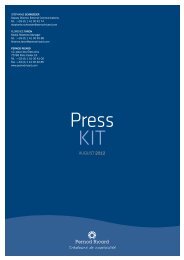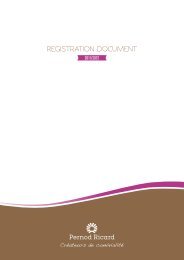Registration Document - Pernod Ricard
Registration Document - Pernod Ricard
Registration Document - Pernod Ricard
You also want an ePaper? Increase the reach of your titles
YUMPU automatically turns print PDFs into web optimized ePapers that Google loves.
CORPORATE GOVERNANCE AND INTERNAL CONTROL 2<br />
Report of the Chairman of the Board of Directors on internal control and risk management<br />
◆ audit missions: 18 internal audits were performed in 2008/2009,<br />
despite the various teams’ high involvement in the integration of<br />
V&S. The objectives of these audits were notably to ensure that the<br />
Group’s internal control principles were correctly applied within its<br />
subsidiaries. They were also used to assess efficiency in managing<br />
the working capital requirement and the main industrial and IT<br />
projects.<br />
The key areas for improvement identified were addressed in specific<br />
action plans, which were validated by General Management and the<br />
Audit Committee. Their implementation is regularly assessed by the<br />
Group’s Internal Audit department.<br />
The work performed enabled the quality of internal control and risk<br />
management to be strengthened within the Group.<br />
Key components of internal control<br />
procedures<br />
The key components of internal control procedures are as follows:<br />
The <strong>Pernod</strong> <strong>Ricard</strong> Charter sets out the rights and duties of every<br />
employee in relation to Group values, particularly in its code of ethics.<br />
Among other things, these rights and duties include compliance with<br />
the law and integrity. A copy of the charter is given to each employee<br />
when they are recruited, and is always available in several languages<br />
on the Group Intranet site.<br />
A formal delegation of authority procedure, issued by the Board<br />
of Directors, sets out the powers of the Chief Executive Officer, the<br />
Managing Directors in charge of Brands, the Distribution Network,<br />
Human Resources and Finance and the General Counsel of the<br />
Holding Company.<br />
The Internal Audit Charter is for all collaborators who have a<br />
management and audit position. It defines the standards, the<br />
missions, the responsibilities, the organisation and the operating<br />
mode of the Group I nternal Audit in order to remind every employee<br />
to strive for compliance with, and improvement of, the I nternal Audit<br />
process.<br />
Group Internal Control Policies, which have been established for each<br />
of the 14 internal control cycles identified, enable the subsidiaries to<br />
concentrate on the internal control procedures related to the Group’s<br />
main risks.<br />
Updated in 2007/2008 to comply with the AMF Reference Framework<br />
for internal control, the s elf-assessment questionnaire is based on<br />
the Group’s internal control policies . In particular, it covers C orporate<br />
G overnance practices, operational matters and IT support and risk<br />
analysis.<br />
Submitted to the Group’s main subsidiaries, it enables them to<br />
assess the adequacy and the effectiveness of their internal control.<br />
Responses to the questionnaires are documented and reviewed in<br />
detail by the Regions and Group Internal Audit department. All of this<br />
work has been covered by:<br />
◆ a summary by subsidiary and an overall Group summary,<br />
which are<br />
both provided to the General Management and Audit Committee;<br />
◆ a letter of representation from each subsidiary, sent to the<br />
Chairman and Chief Executive Officer of their Parent Company and<br />
a letter of representation from the various parent companies sent<br />
to the Chief Executive Officer of <strong>Pernod</strong> <strong>Ricard</strong>. This letter engages<br />
subsidiary management as regards the adequacy of their control<br />
procedures in the light of identified risks.<br />
The Environment and Quality Charter sets out the rules to be<br />
complied with in these areas. The Industrial Operations department<br />
of the Holding Company is in charge of ensuring that they are<br />
followed. An annual report is presented by this department to the<br />
Group Executive Committee.<br />
Budgetary control is organised around three key areas: the annual<br />
budget (revised during the year), monthly reporting to monitor<br />
performance and the three-year strategic plan. Budgetary control is<br />
exercised by the management control teams attached to the finance<br />
departments of the Holding Company and the Regions. It operates as<br />
follows:<br />
◆ the budget is subject to specific instructions (principles, timetable)<br />
published by the Holding Company and sent to all the subsidiaries.<br />
The final budget is approved by the General Management of the<br />
Holding Company;<br />
◆ reporting is prepared on the basis of data directly input by<br />
subsidiaries in accordance with a precise timetable provided at the<br />
beginning of the year and in accordance with the reporting manual<br />
as well as the accounting and financial policies published by the<br />
Holding Company;<br />
◆ monthly performance analysis is carried out as part of the reporting<br />
process and is presented by the Finance Department to the General<br />
Management, the Group Executive Committee and at meetings of<br />
the Board of Directors and the Audit Committee;<br />
◆ a three-year strategic plan for the Group’s main brands is prepared<br />
each year using the same procedures as those used for the budget;<br />
◆ a single management and consolidation system allows each<br />
subsidiary to input all its accounting and financial data directly.<br />
Centralised Treasury Management is led by the Treasury Unit of the<br />
Holding Company’s Finance Department.<br />
Legal and operational control of the<br />
Holding Company over its subsidiaries<br />
Subsidiaries are mostly wholly-owned, either directly or indirectly.<br />
The Holding Company is represented directly or indirectly (through<br />
an intermediate subsidiary) on its subsidiaries’ Boards of Directors.<br />
The Organisation Charter and the Group Internal Control Policies<br />
define the level of autonomy of subsidiaries, particularly with respect<br />
to strategic decisions.<br />
The role of the Holding Company, as described in the “General<br />
Organisation of the Group” paragraph of this report, is an important<br />
component of the control of subsidiaries.<br />
I REFERENCE DOCUMENT 2008/2009 I PERNOD RICARD 33
















